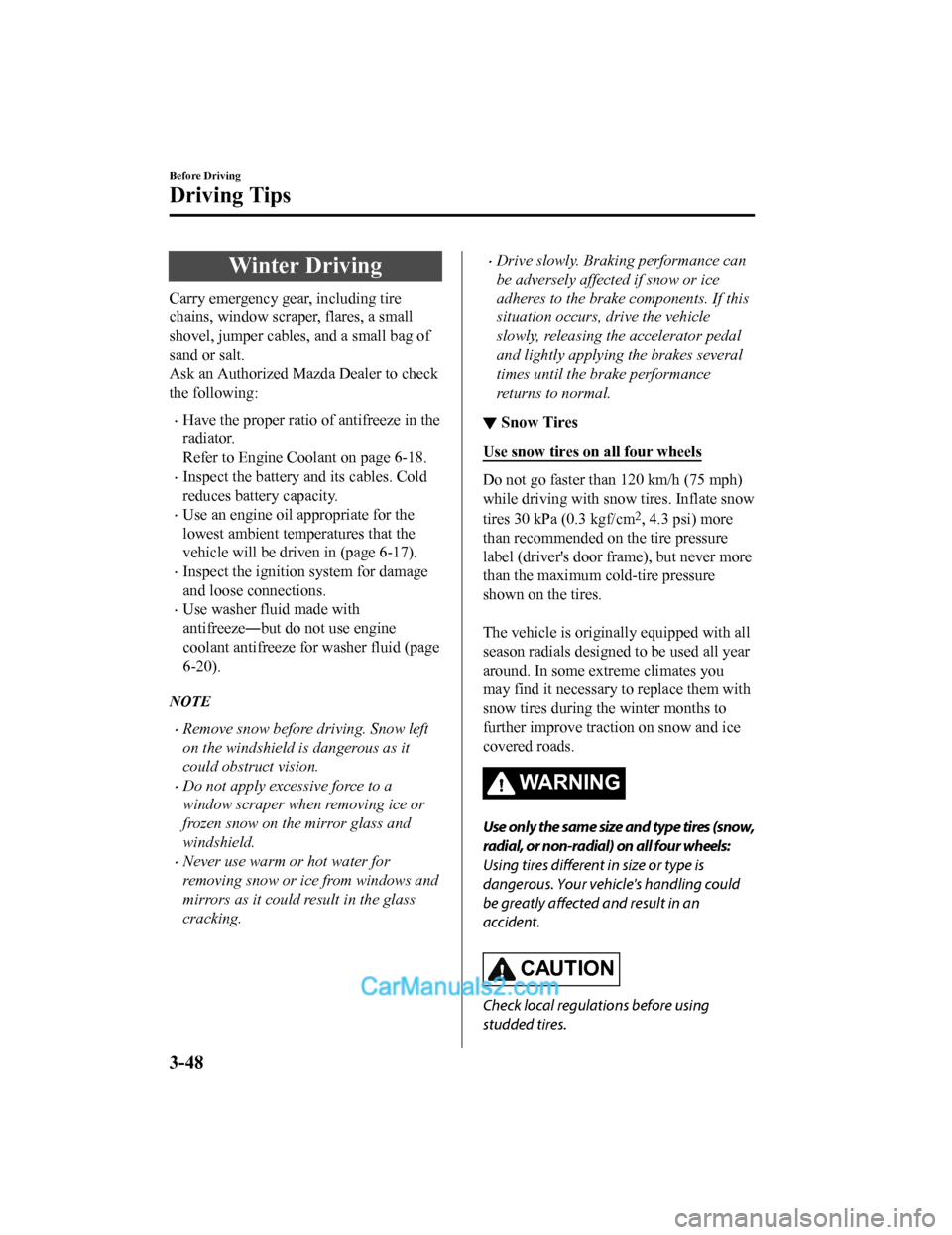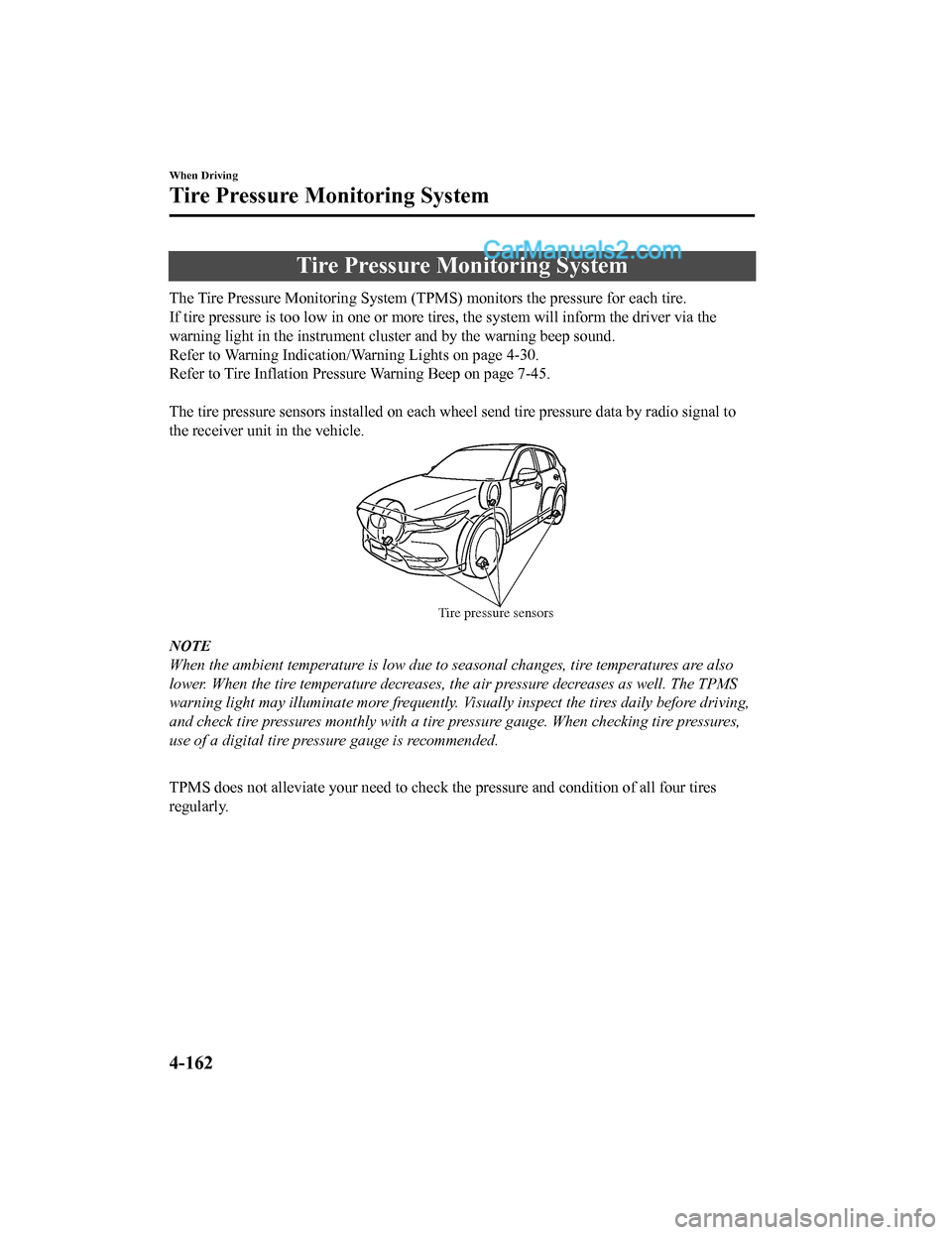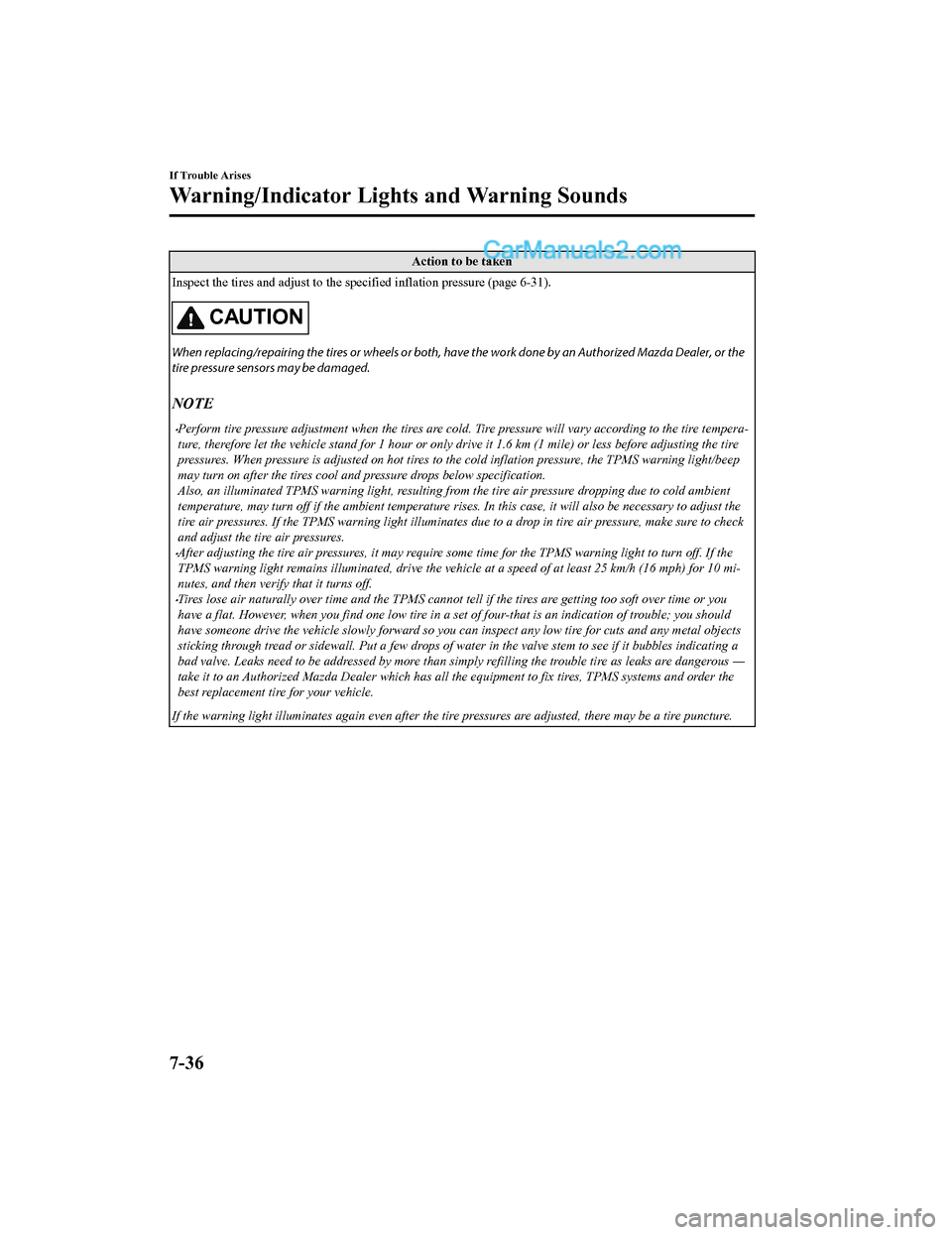four wheel drive MAZDA MODEL CX-5 2018 Owners Manual (in English)
[x] Cancel search | Manufacturer: MAZDA, Model Year: 2018, Model line: MODEL CX-5, Model: MAZDA MODEL CX-5 2018Pages: 628, PDF Size: 82.38 MB
Page 124 of 628

Winter Driving
Carry emergency gear, including tire
chains, window scraper, flares, a small
shovel, jumper cables, and a small bag of
sand or salt.
Ask an Authorized Mazda Dealer to check
the following:
•Have the proper ratio of antifreeze in the
radiator.
Refer to Engine Coolant on page 6-18.
•Inspect the battery and its cables. Cold
reduces battery capacity.
•Use an engine oil appropriate for the
lowest ambient temperatures that the
vehicle will be driven in (page 6-17).
•Inspect the ignition system for damage
and loose connections.
•Use washer fluid made with
antifreeze―but do not use engine
coolant antifreeze for washer fluid (page
6-20).
NOTE
•Remove snow before driving. Snow left
on the windshield is dangerous as it
could obstruct vision.
•Do not apply excessive force to a
window scraper when removing ice or
frozen snow on the mirror glass and
windshield.
•Never use warm or hot water for
removing snow or ice from windows and
mirrors as it could result in the glass
cracking.
•Drive slowly. Braking performance can
be adversely affected if snow or ice
adheres to the brake components. If this
situation occurs, drive the vehicle
slowly, releasing the accelerator pedal
and lightly applying the brakes several
times until the brake performance
returns to normal.
▼ Snow Tires
Use snow tires on all four wheels
Do not go faster than 120 km/h (75 mph)
while driving with sno
w tires. Inflate snow
tires 30 kPa (0.3 kgf/cm
2, 4.3 psi) more
than recommended on the tire pressure
label (driver's door frame), but never more
than the maximum c old-tire pressure
shown on the tires.
The vehicle is originally equipped with all
season radials designed to be used all year
around. In some extreme climates you
may find it necessary t o replace them with
snow tires during the winter months to
further improve traction on snow and ice
covered roads.
WA R N I N G
Use only the same size and type tires (snow,
radial, or non-radial) on all four wheels:
Using tires different in size or type is
dangerous. Your vehi cle's handling could
be greatly affected and result in an
accident.
CAUTION
Check local regulations before using
studded tires.
Before Driving
Driving Tips
3-48
CX-5_8GN5-EA-17J_Edition1 2017-8-18 12:58:27
Page 220 of 628

NOTE
Check the tire inflation pressure label
attached to driver's door frame for the
correct tire inflation pressure.
•Make sure to equip the vehicle with
genuine wheels of the specified size, on
all wheels. With AWD, the system is
calibrated for all four wheels being of
the same dimensions.
Tire chains
•Install tire chains to the front tires.
•Do not use tire chains on the rear
wheels.
•Do not drive the vehicle faster than 30
km/h (19 mph) with the tire chains
installed.
•Do not drive the vehicle with tire chains
on road conditions other than snow or
ice.
▼ To w i n g
If the vehicle requ
ires towing, have it
towed with all four wh eels completely off
the ground.
Refer to Towing Description on page 7-
20.
When Driving
i-ACTIV AWD
4-84
CX-5_8GN5-EA-17J_Edition1 2017-8-18 12:58:27
Page 281 of 628

•The SBS system may not operate under the following conditions:
•If the vehicle is accelerated rapidly and it comes cl ose to a vehicle ahead.
•The vehicle is driven at the same speed as the vehicle ahead.
•The accelerator pedal is depressed.
•The brake pedal is depressed.
•The steering wheel is being operated.
•The selector lever is being operated.
•The turn signal is being used.
•When the vehicle ahead is not equipped with taillights or the taillights are turned off.
•When warnings and messages, such as a dirty windshield, related to the Forward
Sensing Camera (FSC) are being displa yed in the multi-information display.
•Although the objects which activate the syst em are four-wheeled vehicles, the radar
sensor (front) could detect the following objects, determine them to be an obstruction, and
operate the SBS system.
•Objects on the road at the entrance to a curve (including guardrails and snow banks).
•A vehicle appears in the opposite lane while cornering or rounding a curve.
•When crossing a narrow bridge.
•When passing under a low gate or through a tunnel or narrow gate.
•When entering an underground parking area.
•Metal objects, bumps, or protruding objects on the road.
•If you suddenly come close to a vehicle ahead.
•When driving in areas where there is high grass or forage.
•Two-wheeled vehicles such as motorbikes or bicycles.
•Pedestrians or non-metallic objects such as standing trees.
•When the system operates, the user is no tified by the multi-information display.
•The SBS warning indication (amber) turn s on when the system has a malfunction.
Refer to Warning Indication/Warning Lights on page 4-30.
When Driving
i-ACTIVSENSE
4-145
CX-5_8GN5-EA-17J_Edition1 2017-8-18 12:58:27
Page 298 of 628

Tire Pressure Monitoring System
The Tire Pressure Monitoring System (TPMS) monitors the pressure for each tire.
If tire pressure is to o low in one or more tires, the system will inform the driver via the
warning light in the instrument cluster and by the warning beep sound.
Refer to Warning Indication/Warning Lights on page 4-30.
Refer to Tire Inflation Pressu re Warning Beep on page 7-45.
The tire pressure sensors installed on each wheel send tire pre ssure data by radio signal to
the receiver unit in the vehicle.
Tire pressure sensors
NOTE
When the ambient temperature is low due to seasonal changes, tire temperatures are also
lower. When the tire temperature decreases, the air pressure decreases as well. The TPMS
warning light may illumina te more frequently. Visually inspect the tires daily before driving,
and check tire pressures monthly with a tire pressure gauge. When checking tire pressures,
use of a digital tire pressure gauge is recommended.
TPMS does not alleviate your need to check the pressure and con dition of all four tires
regularly.
When Driving
Tire Pressure Monitoring System
4-162
CX-5_8GN5-EA-17J_Edition1 2017-8-18 12:58:27
Page 528 of 628

Towing Description
We recommend that towing be done only
by an Authorized Mazda Dealer or a
commercial tow-truck service.
Proper lifting and towing are necessary to
prevent damage to the vehicle. Particularly
when towing an AWD vehicle, where all
the wheels are connected to the drive train,
proper transporting of the vehicle is
absolutely essential to avoid damaging the
drive system. Government and local laws
must be followed.
Wheel dollies
A towed 2WD vehicle should have its
drive wheels (front wheels) off the ground.
If excessive damage or other conditions
prevent this, use wheel dollies.
When towing a 2WD vehicle with the rear
wheels on the ground, release the parking
brake.
Refer to Electric Parking Brake (EPB) on
page 4-65.
A towed AWD vehicle must have all its
wheels off the ground.
WA R N I N G
Always tow an AWD vehicle with all four
wheels off the ground:
Towing an AWD vehicle with either the
front or rear wheels on the ground is
dangerous as the drive train could be
damaged, or the vehicle could trail away
from the tow truck and cause an accident.
If the drive train has been damaged,
transport the vehicle on a flatbed truck.
CAUTION
Do not tow the vehicle pointed backward
with driving wheels on the ground. This
may cause internal damage to the
transaxle.
If Trouble Arises
Emergency Towing
7-20
CX-5_8GN5-EA-17J_Edition1 2017-8-18 12:58:27
Page 544 of 628

Action to be taken
Inspect the tires and adjust to the specified inflation pressur e (page 6-31).
CAUTION
When replacing/repairing the tires or wheels or both, have the work done by an Authorized Mazda Dealer, or the
tire pressure sens ors may be damaged.
NOTE
•Perform tire pressure adjustment when the tires are cold. Tire pressure will vary according to the tire tempera-
ture, therefore let the vehicle stand for 1 hour or only drive it 1.6 km (1 mile) or less before adjusting the tire
pressures. When pressure is adjusted on hot tires to the cold inflation pressure, the TPMS warning light/beep
may turn on after the tires cool and pressure drops below specification.
Also, an illuminated TPMS warning light, resulting from the tire air pressure dropping due to cold ambient
temperature, may turn off if the ambient temperature rises. In this case, it will also be necessary to adjust the
tire air pressures. If the TPMS warning light illuminates due to a drop in tire air pressure, make sure to check
and adjust the tire air pressures.
•After adjusting the tire air pressures, it may require some time for the TPMS warning light to turn off. If the
TPMS warning light remains illuminated, drive the vehicle at a speed of at least 25 km/h (16 mph) for 10 mi-
nutes, and then verify that it turns off.
•Tires lose air naturally over time an d the TPMS cannot tell if the tires ar e getting too soft over time or you
have a flat. However, when you find one low tire in a set of four-tha t is an indication of trouble; you should
have someone drive the vehicle slowly forward so you ca n inspect any low tire for cuts and any metal objects
sticking through tread or sidewall. Put a few drops of wa ter in the valve stem to see if it bubbles indicating a
bad valve. Leaks need to be addressed by more than simply refilling the trouble tire as leaks are dangerous ―
take it to an Authorized Mazda Dealer which has all th e equipment to fix tires, TPMS systems and order the
best replacement tire for your vehicle.
If the warning light illuminates again even after the tire pressures are adjusted, there may be a tire puncture.
If Trouble Arises
Warning/Indicator Lights and Warning Sounds
7-36
CX-5_8GN5-EA-17J_Edition1 2017-8-18 12:58:27